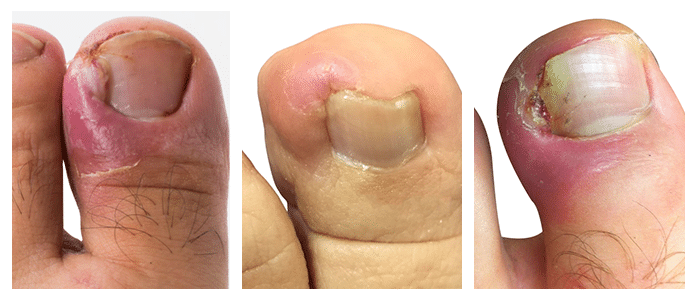Ingrown Toenail Surgery
What causes ingrown toenail issues?
Ingrown toenail often forms on your toes if there is excessive irritation caused by tight footwear or wrong toenail clipping method. Any of your toenails can become ingrown, but the problem more often affects the big toe.
An ingrown nail occurs when the skin on one or both sides of a nail grows over the edges of the nail, or when the nail itself grows into the skin. Redness, pain and swelling at the corner of the nail may result and infection may soon follow.
Sometimes a small amount of pus can be seen draining from the area.
How do I know if I have ingrown nails?
If excessive inflammation, swelling, pain and discharge are present, the toenail is probably infected and should be treated by an experienced Foot and Ankle physician.
If your toe nail looks like one of the toes below, then you should come see us for an appointment. If the nail is left untreated, there is a high chance it can become infected and cause you additional pain.

The best treatment course: Minor surgery
If you elect do have the minor surgery done, the procedure will be done inside our surgical room.

FAQ:
Q. What can I expect with my appointment?
We will assess your problem toenail/s and prescribe her recommended services. If you consent, we will proceed with a procedure.
Sometimes patients come in thinking they have an ingrown toenail, and instead they have a fungal infection. It is always the safest and quickest to come in and have a professional inspect the problem area.
Q. What is the recovery time?
1 Week – 2 weeks
Q. Can I use my private health for the surgical procedure?
Yes you can. As long as you have podiatry coverage, we can make a claim with our HICAPS terminal.
Q. Can I wear closed-in shoes after surgery?
Ideally no. But we understand that some people can’t take time off work or are not allowed to wear open toe shoes, even with a medical certificate.
If you are someone that absolutely can’t wear open shoes after surgery. It is very important you clean and redress your wound every day. It is best you schedule in a follow up appointment 1-3 days after surgery, so we can check how things are healing.
Q. Can I get surgery in my initial appointment?
In most situations, yes you can. It is only the most extreme where we may need to book you in another day. But when you book with us over the phone or online, we can discuss the full extent of your issue and schedule in a little more time for your appointment. That will ensure diagnoses and surgery can happen on the same appointment.
Q. What is the difference between the PNA procedure and the Winograd procedure?
If your toenail is heavily infected, if the PNA procedure is carried out, there is a high chance of failure. Why you ask?
The nail has too much hyper-granulated tissue to properly see the nail to perform surgery. Without removing the hyper-granulated tissue before hand, greatly increases the risk of infection and a failed surgery.
The winograd procedure fixes all that, as the hyper-granulated tissue is removed as part of the procedure.
Q. I believe I need surgery done, but I’m scared it’s going to hurt!
Have no fear. We have had countless patients come through that have thought the same thing when they entered our doors. When they left, they all said the same things, “I can’t believe it didn’t hurt at all!”.
Dr Kim & Lewis have a technique they use to avoid almost all pain. You won’t even feel the needle of the local anesthesia!
If you have anymore questions, please feel free to call or send an email to us. We are here to help.
Would this procedure suit my situation?
This procedure is for patients with infected toes or a long history with ingrown toenail issues.
Surgical Procedure 1: Partial nail avulsion with phenol acid (PA) or Trichloroacetic acid (TCA).
Phenol acid cauterisation offers painless, quick recovery (1-2 days), cosmetically satisfying removal of partial toenail with a success rate of 80%.
Whereas, TCA cauterisation offers painless, moderate recovery rate (5-10days), cosmetically satisfying removal of partial toenail with a success rate of 98%.
Would this procedure suit my situation?
This surgical procedure works only for patients who are not experiencing any infections symptoms (puss and inflammation at the nail edge) and have long term issues with ingrown toenail pain.
If your toenail is infected, it is best you book under the Winograd procedure.
Surgical Procedure 2: Modified Winograd procedure with Noel’s technique
This procedure is very special, as most podiatrists can not perform this procedure. When done properly, you should never experience ingrown pain every again.
The modified winograd procedure can be used on even the most complex cases. We have treated patients with long histories of repeated ingrown toenail issues with this procedure.
What differs this procedure from the other procedures?
In this procedure, Dr Kim will remove the remove all the hyper-granulated tissue around the affected nail.
From there the offending nail and nail bed area is removed, and reshaped, so the issues does not repeat it’s self.
4-5 stitches adhere to the excision site which are removed once the area is healed.
Make an appointment with one of our Ingrown Toenail Specialists
Principal Podiatrist
& Medical Director
Bookings with Dr Kim are to be done by appointment.
Please call the clinic directly.




